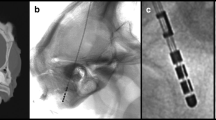Abstract
Background
The two middle contacts of directional leads (d-leads) for deep brain stimulation are split into three segments, allowing current steering toward desired axial directions. To facilitate programming, their final orientation needs to be reliably determined. However, it is currently unclear whether d-leads rotate after implantation. Our objective was to assess the degree of d-lead rotation after implantation.
Methods
We retrospectively analyzed d-lead orientation on intraoperative X-rays, postoperative CT scans (latencies to surgery: 108–189 min postoperatively), and rotational fluoroscopies (4–9 days postoperatively) for a consecutive series of 32 implanted d-leads. For five d-leads, a CT scan with a mean follow-up of 57 days (range 28–182) was available. All d-leads were implanted with the marker facing anterior and the intention to hit an “iron sight” (ISi) on the X-ray, indicating anterior orientation (i.e., 0° ± 6°).
Results
In nine d-leads, an ISi was visible on the final X-ray; median orientation was 1.5° (range 0.5–6.0°) at the first follow-up CT, confirming anterior orientation. In d-leads without ISi or where ISi was not evaluable, the median rotation was 15.5° (9.5–35.0°) and 26.5° (5.5-62.0°), respectively. The orientation of the initial CT was comparable with the orientation determined by the postoperative rotational fluoroscopy and second CT in all d-lead groups.
Conclusion
D-lead orientation does not change within the first week after implantation. We provide first indications that d-lead orientation remains stable for several weeks after surgery. Determination of lead orientation using marker-based X-ray alone seems too imprecise; adding the ISi method can increase determination of intraoperative orientation.



Similar content being viewed by others
References
Asahi T, Ikeda K, Yamamoto J, Tsubono H, Sato S (2019) Pilot study for considering subthalamic nucleus anatomy during stimulation using directional leads. J Mov Disord 12(2):97–102
Dembek TA, Reker P, Visser-Vandewalle V, Wirths J, Treuer H, Klehr M, Roediger J, Dafsari HS, Barbe MT, Timmermann L (2017) Directional DBS increases side-effect thresholds—a prospective, double-blind trial. Mov Disord 32(10):1380–1388
Dembek TA, Hoevels M, Hellerbach A et al (2019) Directional DBS leads show large deviations from their intended implantation orientation. Parkinsonism Relat Disord. https://doi.org/10.1016/j.parkreldis.2019.08.017
Hellerbach A, Dembek TA, Hoevels M, Holz JA, Gierich A, Luyken K, Barbe MT, Wirths J, Visser-Vandewalle V, Treuer H (2018) DiODe: Directional orientation detection of segmented deep brain stimulation leads: a sequential algorithm based on CT imaging. Stereotact Funct Neurosurg 96(5):335–341
Hunsche S, Neudorfer C, Majdoub FE, Maarouf M, Sauner D Determining the rotational orientation of directional deep brain stimulation leads employing flat-panel computed tomography. Oper Neurosurg. https://doi.org/10.1093/ons/opy163
Pollo C, Kaelin-Lang A, Oertel MF, Stieglitz L, Taub E, Fuhr P, Lozano AM, Raabe A, Schüpbach M (2014) Directional deep brain stimulation: an intraoperative double-blind pilot study. Brain 137(7):2015–2026
Reinacher PC, Krüger MT, Coenen VA, Shah M, Roelz R, Jenkner C, Egger K (2017) Determining the orientation of directional deep brain stimulation electrodes using 3D rotational fluoroscopy. Am J Neuroradiol. https://doi.org/10.3174/ajnr.A5153
Sitz A, Hoevels M, Hellerbach A, Gierich A, Luyken K, Dembek TA, Klehr M, Wirths J, Visser-Vandewalle V, Treuer H (2017) Determining the orientation angle of directional leads for deep brain stimulation using computed tomography and digital x-ray imaging: a phantom study. Med Phys 44(9):4463–4473
Steigerwald F, Müller L, Johannes S, Matthies C, Volkmann J (2016) Directional deep brain stimulation of the subthalamic nucleus: a pilot study using a novel neurostimulation device. Mov Disord 31(8):1240–1243
Steigerwald F, Matthies C, Volkmann J (2018) Directional deep brain stimulation. Neurotherapeutics. https://doi.org/10.1007/s13311-018-0667-7
Ten Brinke TR, Odekerken VJJ, Dijk JM, van den Munckhof P, Schuurman PR, de Bie RMA (2018) Directional deep brain stimulation: first experiences in centers across the globe. Brain Stimulat. https://doi.org/10.1016/j.brs.2018.04.008
Acknowledgments
We thank Rebecca Kurtev-Rittstieg (Brainlab) for her support regarding technical and software aspects. Editorial assistance was provided by Deborah Nock (Medical WriteAway, Norwich, UK).
Author information
Authors and Affiliations
Contributions
Research project: A. conception, MTK, and PCR; B. organization, MTK, YN, and FB; C. execution, MTK, FC, JW, and YN
Statistical analysis: A. design, FB and MTK; execution, FB, GK, and SHL; B. review and critique, all authors
Manuscript: A. writing of first draft, MTK and FB; B. review and critique, all authors
Images: A. conception and drawings, MTK; B. review and critique, all authors
Corresponding author
Ethics declarations
Conflict of interest
Related to this work: MTK has received travel funding from Boston Scientific (manufacturer of the electrodes used in this study). She is a consultant for Brainlab (manufacturer of the planning software used in this study). PCR has received occasional honoraria and travel support from Brainlab AG; he is a consultant for Boston Scientific. The companies had no involvements in the collection, analysis, and interpretation of the data nor in writing, editing, or submitting the manuscript.
Unrelated to this work: MTK has received travel funding from Medtronic. FC holds shares in varying amounts of different companies in medically related fields as a private investor (Amyra Biotech AG, Fresenius SE & Co. KGaA). JW has a partnership with Siemens Healthineers and Artis Q. SHL has received travel funding from AbbVie, Switzerland. FB has received a scholarship by the Baasch-Medicus Foundation, Zurich, and a research grant by the KSSG Forschungskommission.
Statement of ethics
The clinical characteristics and scan-related outcome parameters were obtained as part of the patients’ routine care. All data was stored on an in-house database that was approved by the local ethics committee. All patients gave their written informed consent to be included in the database.
Additional information
Publisher’s note
Springer Nature remains neutral with regard to jurisdictional claims in published maps and institutional affiliations.
This article is part of the Topical Collection on Functional Neurosurgery–Other
Electronic supplementary material
ESM 1
(DOCX 709 kb)
Rights and permissions
About this article
Cite this article
Krüger, M.T., Naseri, Y., Cavalloni, F. et al. Do directional deep brain stimulation leads rotate after implantation?. Acta Neurochir 163, 197–203 (2021). https://doi.org/10.1007/s00701-020-04568-3
Received:
Accepted:
Published:
Issue Date:
DOI: https://doi.org/10.1007/s00701-020-04568-3




